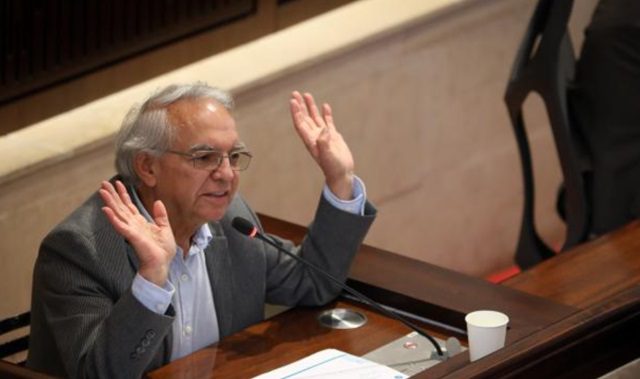BTN News: The 2025 General Budget of the Nation, recently presented by the Ministry of Finance before Congress, marks a crucial financial roadmap for Colombia. With a staggering total of 523 trillion pesos, this budget reflects the government’s priorities and challenges as it grapples with balancing expenses, managing debt, and fostering investment in a complex economic landscape. Of this massive budget, a significant 62.7 percent, equivalent to 327.9 trillion pesos, is allocated to operating expenses, underscoring the essential costs required to keep the government functioning effectively. Additionally, 112.6 trillion pesos, or 21.5 percent, is earmarked for debt repayment, while the remaining 82.4 trillion pesos, representing 15.8 percent, is designated for investment, a key driver of economic growth and development.
However, the budget’s carefully laid plans hinge on the anticipated revenue sources, which include a proposed 12 trillion pesos from a new financing law. This law is crucial for bridging the gap between the planned expenses and the available income. The budget’s revenue structure is divided into three primary sources: tax revenues, non-tax revenues, and a miscellaneous category that includes significant contributions from Ecopetrol, Colombia’s state oil company. For the upcoming fiscal year, the government anticipates total revenues of 312 trillion pesos, marking an increase of 31.1 trillion pesos from the previous year. This growth is attributed to a combination of improved tax collection efforts by the DIAN (National Tax and Customs Directorate), which is expected to bring in an additional 14.6 trillion pesos, capital resources amounting to 4.5 trillion pesos, and the crucial 12 trillion pesos anticipated from the new financing law.
In comparison to the previous year, tax revenues are projected to increase significantly, from 289.9 trillion pesos to 316.5 trillion pesos in 2025, a difference of 26.6 trillion pesos. This increase is a reflection of the government’s ongoing efforts to enhance tax collection and broaden the tax base. Non-tax revenues, on the other hand, are expected to remain stable at 1.3 trillion pesos, indicating a reliance on consistent sources of income outside of traditional taxation. Meanwhile, revenues from Ecopetrol are forecasted to rise from 6.4 trillion pesos to 8.1 trillion pesos, contributing an additional 1.6 trillion pesos to the national coffers.
The Minister of Finance, Ricardo Bonilla, highlighted that current revenues are estimated at 305.8 trillion pesos, with 266 trillion pesos coming from domestic taxes and 38 trillion pesos from external tax revenues. Bonilla emphasized that the nation’s income is primarily derived from tax collection, with non-tax revenues playing a relatively minor role. This reliance on tax revenues underscores the importance of effective tax policy and administration in maintaining the nation’s fiscal health.
In terms of capital resources, the government expects to receive 156 trillion pesos. This includes 60 trillion pesos from domestic credit, 19 trillion pesos from surpluses, 38 trillion pesos from external credit, 8 trillion pesos from balance resources, and 29 trillion pesos from other capital income. These funds are critical for supporting various public investments and ensuring the government’s ability to meet its financial obligations.
Public institutions are also accounted for in the budget, with 27.3 trillion pesos allocated to them. However, the overall financial plan is not without its challenges. The budget outlines financing for 511 trillion pesos, leaving a gap of 12 trillion pesos that the government intends to cover through the proposed financing law. This shortfall has raised concerns among fiscal watchdogs, including the Autonomous Committee of the Fiscal Rule (Carf), which has highlighted the risks associated with relying on uncertain revenue sources.
The Carf’s analysis points to a potential shortfall in revenue collection, estimating that only 6 trillion pesos might be realistically generated through improved tax management, far below the 28.6 trillion pesos assumed in the budget proposal. This discrepancy underscores the risks inherent in planning expenditures based on uncertain revenues. The committee has also warned that the government may need to cut spending by over 22.6 trillion pesos to comply with fiscal rules in the coming year.
Moreover, the Carf has expressed concern that, similar to the previous year, the 2025 budget includes planned expenditures tied to uncertain revenue streams. This practice, according to the committee, could jeopardize the achievement of the Net Structural Primary Balance target, increase fiscal uncertainty, complicate fiscal planning, and potentially necessitate spending cuts later in the year to comply with fiscal regulations.
In conclusion, the 2025 General Budget of the Nation reflects the Colombian government’s ambitions to balance necessary spending with economic growth initiatives. However, the reliance on uncertain revenue sources, coupled with the risks highlighted by the Carf, suggests that achieving these goals will require careful fiscal management and possibly difficult adjustments as the year progresses. As the budget moves through the legislative process, these challenges will undoubtedly be a focal point of debate and discussion, with significant implications for the nation’s economic stability and growth.


